Biomechanical Analysis of Weightlifter During Classic Jerk Based on High-Speed Video Recording and Computer Simulation
Фотографии:
ˑ:
L.A. Khasin, associate professor, Ph.D.
Research institute of information technologies, Moscow state academy of physical culture
Russian state academy of physical culture, Malakhovka
Key words: weightlifting, technique, biomechanical analysis, high-speed video recording, computer simulation.
One of the principal approaches being currently applied when estimating weightlifters' technical skills is the use of group model characteristics resulting from the studies held on the weightlifting departments of SCOLIPhC, MSAPhC and other sports universities in the 70-80-s of the last century. They included the phase structure of competitive exercises, values of articular angles, weight speed, effort applied on the support by an athlete and weight motion path and acceleration. First of all, the technique was evaluated by the values of several variables at the phase boundaries. These model characteristics have been in the basis of training programs for weightlifting experts in the last 30 years.
The purpose of the study was to analyze the technique of performance of a classic snatch using the high-speed video recording and computer simulation.
Materials and methods. The study was conducted in RIIT in 2010-2013. The object of the research was the technique of elite weightlifters, and its research methods included high-speed video recording, computer simulation, teacher observations.
Our studies have shown that the technique of performance of competitive exercises of the strongest domestic and foreign elite weightlifters has changed significantly, including their phase structure. The principles of creation of force are not well understood. Moreover, the elements of movements that in the 70-80s were treated as errors today are in the range of the strongest athletes. The use of group model characteristics that show general trends and are not intended for evaluation of an individual technique is also a significant drawback of the present evaluation techniques of technical skills of weightlifters. Other drawbacks include: a) low accuracy of measurement; b) inability to use contactless measurement methods; c) overdetermination of the system of indicators which complicates decision-making.
Some drawbacks are eliminated by using the technique described in [1]. However, there is a fundamental problem of estimating technical skills of weightlifters. The latter is impossible based on the old methodology. It can be not only useless, but even harmful to make recommendations within the previous ideas about technique, while it has changed significantly.
In order to design a modern technique of estimation of weightlifters’ skills, researches are required using motion registration systems that provide measurement accuracy of phase durations at the level of 1-2 ms. According to our analysis conducted in 2012, in some cases video recording is required at a speed of not less than 2000 frames/sec.
The above stipulates for the need for: a) describing the present technique of elite weightlifters; b) developing a methodology for assessment and enhancement of technical skills for the modern technique of execution of weightlifting exercises; c) developing approaches to the elaboration of individual model characteristics; d) methodology of motion registration, providing the necessary measurement accuracy and enabling its non-contact use; d) method of analysis of results of registration, used to calculate spatial-temporal, kinematic and dynamic characteristics. Used technical performance criteria must be consistent.
To solve these problems one will need a large amount of high-speed video recording and the subsequent analysis of the findings.
We have reached a new target. We have to develop a methodology that could estimate individual characteristics of technical skills of elite weightlifters thanks to high accuracy of registration of spatio-temporal characteristics, i.e. the "living motion microscopy" and using advanced mathematical methods for data analysis and processing.
The present paper presents an analysis of a classic snatch performed (based on high-speed video recording) by one of the strongest Russian weightlifters. Barbell weight - 150 kg, which is more than 80 % of the athlete’s best result at that point of time.
We used the previously developed technique to calculate kinematic, dynamic and spatio-temporal characteristics of weightlifting exercises on the basis of high-speed video recording.
The results of the analysis of high-speed video recording and the information processing data promoted the description of the modern technology of performance of the classic snatch.
The following motion characteristics of the apparatus were calculated: movement along the X and Y axes, velocity (Vх, Vy), acceleration (ax, ay), force (Fx, Fy) at any point of time, as well as time intervals.
Results and discussion. Let us consider the curves of some individual motion characteristics, calculated for our example.
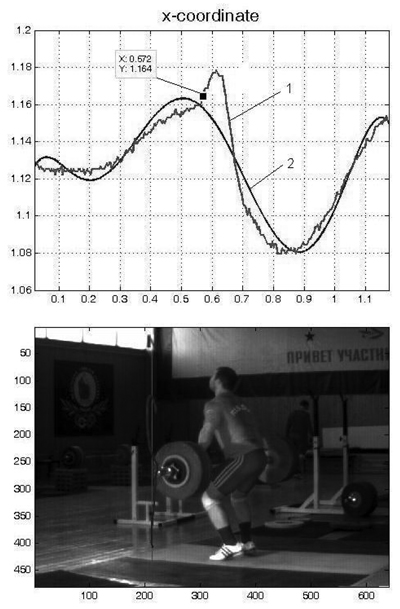
Fig. 1. X coordinate of displacement of the grip end: 1 – the curve of displacement of the grip end; 2 - displacement curve approximation
Fig. 1 shows the curve of the horizontal displacement of weight (grip end) and its approximation. The shape of the curve is typical for elite athletes. It is seen that at the beginning of an exercise an athlete raises an apparatus almost vertically. The amount of movement of the apparatus in the horizontal plane from the start to the point corresponding to the time 0,25 sec, is practically equal to zero. At this point the bar is located at the knee level.
The point marked on the graph corresponds to the beginning of the rapid back extension and displacement of the point of contact of hips with a grip up and forward. Next an athlete moves a bar along the hips, and then pushes it forward. The dislocation of an apparatus forward from the beginning of pushing to the point of maximum horizontal removal of the bar from an athlete is about 10 cm. As seen from Fig. 1, the approximation of the horizontal displacement x in the phase of pushing an apparatus with hips is significantly different from the actual dislocation. Therefore, the estimates Fx and Vx in the above moments of time are not as accurate as the estimates y, Vy and Fy, for which good approximation has been found. The maximum horizontal speed is about 0,41 m/s and corresponds to the situation when an athlete changing to a sitting position moves the bar to himself. At the time of fixing of an apparatus an athlete reduces the bar speed directed toward him and creates a force directed away from him.
Maximum horizontal velocity of bar displacement from an athlete is 0,38 m/s. The horizontal effort at various points of time ranges from 42 to 62 kG. The latter corresponds to the time when an athlete affects an apparatus after pushing and when hands are in an almost horizontal position. In this case, x, Vx and Fx are calculated by the curve approximation of displacement x of the end bar and are highly accurate due to the above reasons (Fig. 1).
Fig. 2 shows the moment of reaching the maximum height of the bar lift. The maximum vertical velocity of the bar lift is 1,9 m/s and corresponds to the position (Fig. 3), when an athlete is on his toes, knees and hips straight. Fig. 3 shows that slowing the growth rate of the bar starts at the time 0,25 s. Slower growth rate starts 0,15 s before the amortization phase. The maximum vertical effort made in the preliminary acceleration phase (Fig. 4) corresponds to the time 0,152 s and is equal to 150 % of the weight of the whole apparatus. The start of the amortization phase (Fig. 5) corresponds to the moment 0,4 s. When pushing (Fig. 6, time 0,612 s) the achieved effort is 191 kg, which corresponds to ≈ 120 % of the weight of the whole apparatus. When an athlete changes to a sitting position the maximum decelerating force is reached at 0,96 s and is 28 kg. The value of the vertical compressive force when fixing a bar over the head is 257 kg, which corresponds to ≈ 170 % of the weight of the whole apparatus. At the beginning of the breakaway the value of the vertical force is 224 kg. The maximum vertical force in the push phase is 191 kg (Fig. 4).
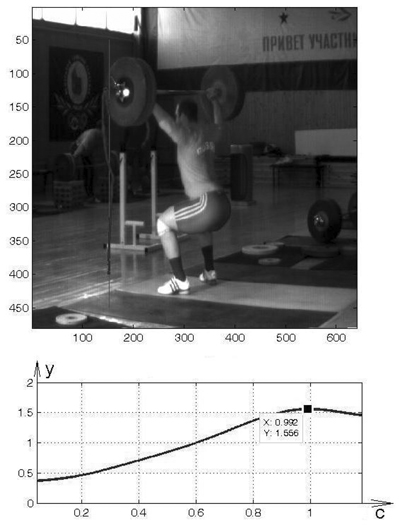
Fig. 2. Vertical dislocation of the apparatus. Pose upon reaching Ymax
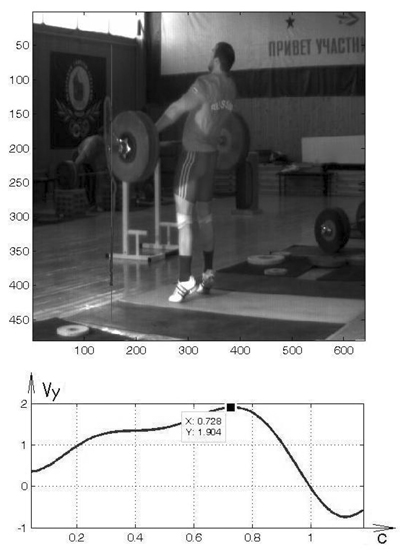
Fig. 3. Bar vertical velocity curve upon reaching Vy max
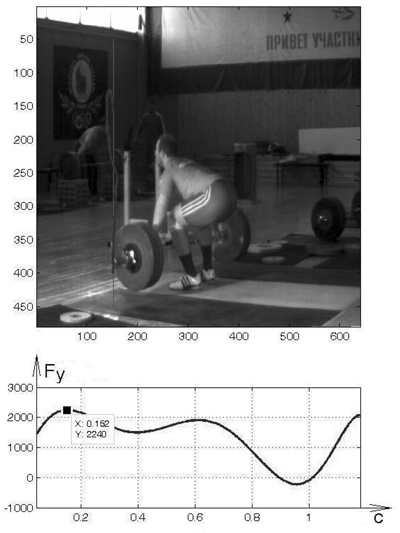
Fig 4. The curve of the vertical force Fy, applied to a bar. The position of the first maximum Fy
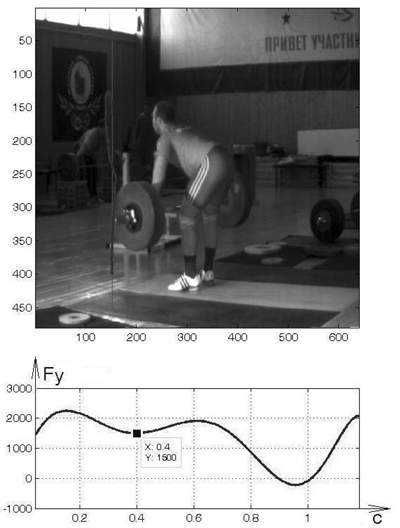
Fig. 5. The curve of the vertical force Fy, applied to a bar. The position corresponding to the beginning of the amortization phase
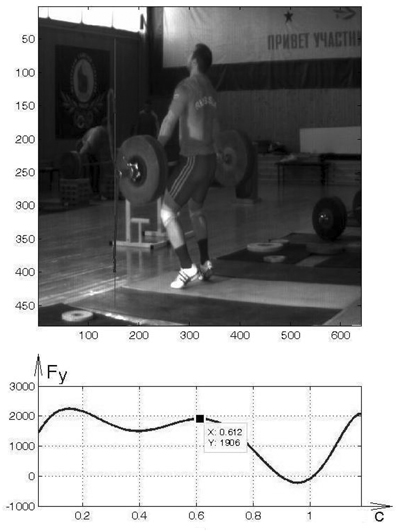
Fig. 6. The curve of the vertical force Fy, applied to a bar. The position corresponding to the beginning of the simultaneous extension of knee and hip joints and pushing a bar with hips
Classical concepts of the technique of performance of weightlifting exercises (the concepts of 70-80s of the last century) set the following procedure: pre-acceleration, amortization phase, final acceleration, at the end of which an athlete stands on his toes. The pre-acceleration is executed with foot flat on the ground.
Our video computer analysis of athlete’s movements shows that the duration of the start acceleration is 0,48 seconds. During the execution of the amortization phase an athlete stands on tiptoes 0,5 seconds after the start (Fig. 7). If we consider that the duration of the amortization phase is equal to 0,134, then the instant of the heels lifting occurs early in this phase. This fact contradicts the previously described concepts of the rational technology.
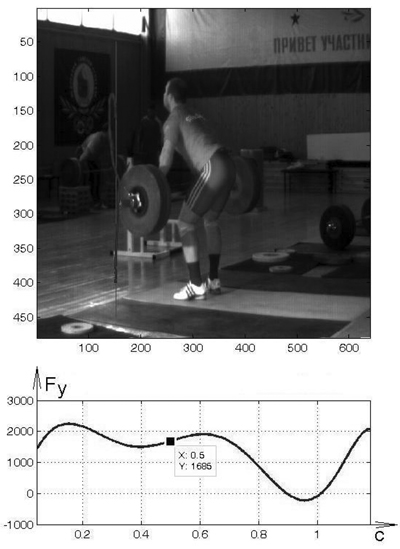
Fig. 7. The curve of the vertical force Fy, applied to a bar. The position corresponding to the heels lifting
The bar push performed in 0,64 s is another important difference. The maximum vertical force exerted by an athlete on an apparatus corresponds to the same point of time. At the beginning of pushing a bar a very rapid extension in the hip joints and then straightening of legs occur. You can talk about the two-cycle implementation of this motion fragment. This motion fragment can be analyzed using high-speed video recording. This fact agrees well with the concepts of physiology "force", i.e. thanks to alternate joining of single muscle groups these muscle groups can create big efforts than if the extension in knee and hip joints was simultaneous.
The third difference is that in the end of the final acceleration an athlete recedes significantly and thus continues the effect on the apparatus. This is also proved by the fact that after straightening ankle, knee and hip joints the movement of the bar is not ballistic. Maximum height of approach is somewhat larger than for the free movement of the bar with a speed corresponding to the moment of extension of the above joints.
Accordingly, additional vertical force is created due to the athlete’s receding and the position of hands at the 45о angle to the horizon.
Changing to the sitting position, an athlete is to move the bar above his head by pulling the bar to himself. The force is directed along hands, it can be separated to two components: horizontal, that moves the bar to an athlete, and vertical, that brakes the apparatus (Fig. 8). If the horizontal deflection of the bar is too big, then, as seen from the graph, a large vertical force will be created, which is undesirable.
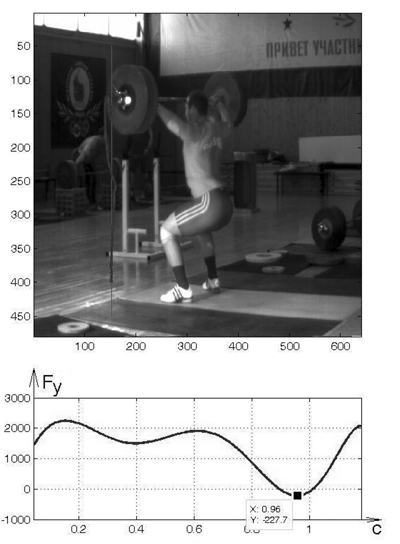
Fig. 8. The curve of the vertical force Fy, applied to a bar. Athlete changing to sitting position
The example we have presented highlights the need for further study of the technique of execution of weightlifting exercises.
Conclusion. The conducted statistical analysis of the measured and calculated motion characteristics showed good agreement with some data presented in the literature sources. These are the values of average phase duration, maximum vertical velocity etc. Meanwhile, we calculated a number of new indicators (vertical and horizontal velocities, forces, acceleration of the apparatus in different moments of performance of a classic snatch). In respect to methodology, the important difference is the fact that the data given in the literature on the phase duration spread is much smaller than those we obtained in the study of elite athletes' movements. For example, the average duration of the amortization phase is in the range of 0,13 ± 0,01 seconds. The phase length of depreciation in a classic snatch ranges from 0,09 to 0,16 s, which makes it significantly harder to use the group model characteristics.
Generally, the literature implies the identity of the phase structure (in terms of duration) of elite athletes, which is the basis for the approval of the ideology of model characteristics. Meanwhile, according to our data, significant differences are observed in individual indicators. Thus, the average duration of the amortization phase for the strongest Russian athletes may differ by almost two times. If we accept the hypothesis on the equal duration of the amortization phase of two strongest Russian weightlifters today, the probability of existence of our data will be less than one percent.
This is a reason for the creation and practical application of individual model characteristics. In previous studies we have shown that individual characteristics can be obtained by analyzing the microstructure of movements, for which it is possible to use high-speed video recording and modern methods of information processing.
References
- Khasin, L.A. Diagnostics of faults in weightlifting exercises based on high-speed video recording / L.A. Khasin, V.I. Frolov // Teoriya i praktika fizicheskoy kultury. – 2013. – № 1. – P. 34–36. (In Russian)
Author’s contacts: niit1995@mail.ru




 Журнал "THEORY AND PRACTICE
Журнал "THEORY AND PRACTICE